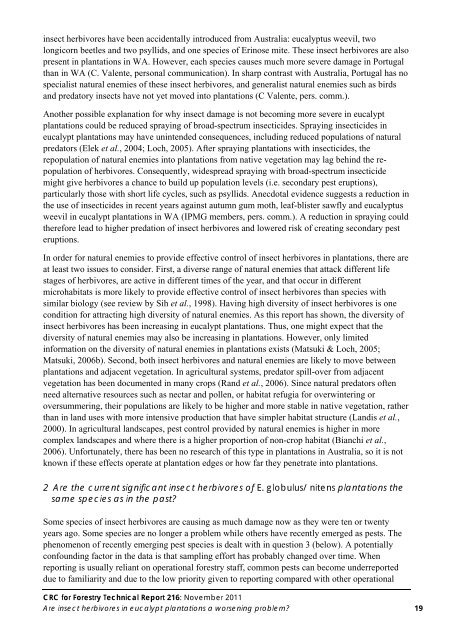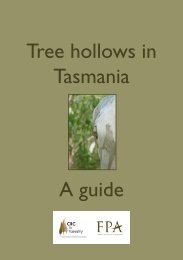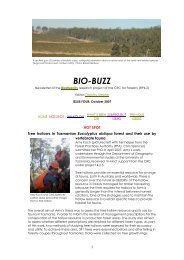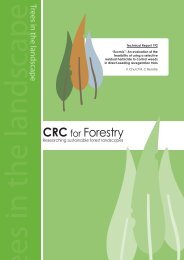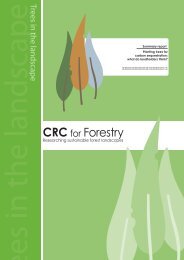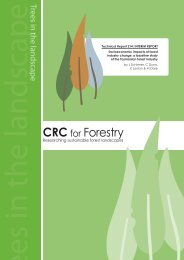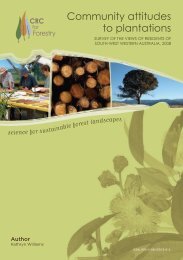CRC Forestry - CRC for Forestry
CRC Forestry - CRC for Forestry
CRC Forestry - CRC for Forestry
Create successful ePaper yourself
Turn your PDF publications into a flip-book with our unique Google optimized e-Paper software.
insect herbivores have been accidentally introduced from Australia: eucalyptus weevil, two<br />
longicorn beetles and two psyllids, and one species of Erinose mite. These insect herbivores are also<br />
present in plantations in WA. However, each species causes much more severe damage in Portugal<br />
than in WA (C. Valente, personal communication). In sharp contrast with Australia, Portugal has no<br />
specialist natural enemies of these insect herbivores, and generalist natural enemies such as birds<br />
and predatory insects have not yet moved into plantations (C Valente, pers. comm.).<br />
Another possible explanation <strong>for</strong> why insect damage is not becoming more severe in eucalypt<br />
plantations could be reduced spraying of broad-spectrum insecticides. Spraying insecticides in<br />
eucalypt plantations may have unintended consequences, including reduced populations of natural<br />
predators (Elek et al., 2004; Loch, 2005). After spraying plantations with insecticides, the<br />
repopulation of natural enemies into plantations from native vegetation may lag behind the repopulation<br />
of herbivores. Consequently, widespread spraying with broad-spectrum insecticide<br />
might give herbivores a chance to build up population levels (i.e. secondary pest eruptions),<br />
particularly those with short life cycles, such as psyllids. Anecdotal evidence suggests a reduction in<br />
the use of insecticides in recent years against autumn gum moth, leaf-blister sawfly and eucalyptus<br />
weevil in eucalypt plantations in WA (IPMG members, pers. comm.). A reduction in spraying could<br />
there<strong>for</strong>e lead to higher predation of insect herbivores and lowered risk of creating secondary pest<br />
eruptions.<br />
In order <strong>for</strong> natural enemies to provide effective control of insect herbivores in plantations, there are<br />
at least two issues to consider. First, a diverse range of natural enemies that attack different life<br />
stages of herbivores, are active in different times of the year, and that occur in different<br />
microhabitats is more likely to provide effective control of insect herbivores than species with<br />
similar biology (see review by Sih et al., 1998). Having high diversity of insect herbivores is one<br />
condition <strong>for</strong> attracting high diversity of natural enemies. As this report has shown, the diversity of<br />
insect herbivores has been increasing in eucalypt plantations. Thus, one might expect that the<br />
diversity of natural enemies may also be increasing in plantations. However, only limited<br />
in<strong>for</strong>mation on the diversity of natural enemies in plantations exists (Matsuki & Loch, 2005;<br />
Matsuki, 2006b). Second, both insect herbivores and natural enemies are likely to move between<br />
plantations and adjacent vegetation. In agricultural systems, predator spill-over from adjacent<br />
vegetation has been documented in many crops (Rand et al., 2006). Since natural predators often<br />
need alternative resources such as nectar and pollen, or habitat refugia <strong>for</strong> overwintering or<br />
oversummering, their populations are likely to be higher and more stable in native vegetation, rather<br />
than in land uses with more intensive production that have simpler habitat structure (Landis et al.,<br />
2000). In agricultural landscapes, pest control provided by natural enemies is higher in more<br />
complex landscapes and where there is a higher proportion of non-crop habitat (Bianchi et al.,<br />
2006). Un<strong>for</strong>tunately, there has been no research of this type in plantations in Australia, so it is not<br />
known if these effects operate at plantation edges or how far they penetrate into plantations.<br />
2 Are the current significant insect herbivores of E. globulus/ nitens plantations the<br />
same species as in the past?<br />
Some species of insect herbivores are causing as much damage now as they were ten or twenty<br />
years ago. Some species are no longer a problem while others have recently emerged as pests. The<br />
phenomenon of recently emerging pest species is dealt with in question 3 (below). A potentially<br />
confounding factor in the data is that sampling ef<strong>for</strong>t has probably changed over time. When<br />
reporting is usually reliant on operational <strong>for</strong>estry staff, common pests can become underreported<br />
due to familiarity and due to the low priority given to reporting compared with other operational<br />
<strong>CRC</strong> <strong>for</strong> <strong>Forestry</strong> Technical Report 216: November 2011<br />
Are insect herbivores in eucalypt plantations a worsening problem? 19


